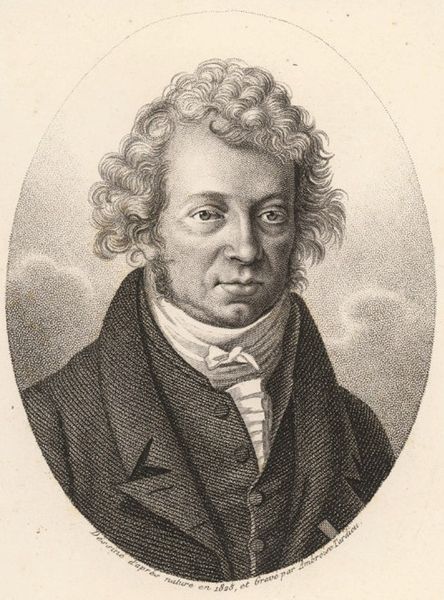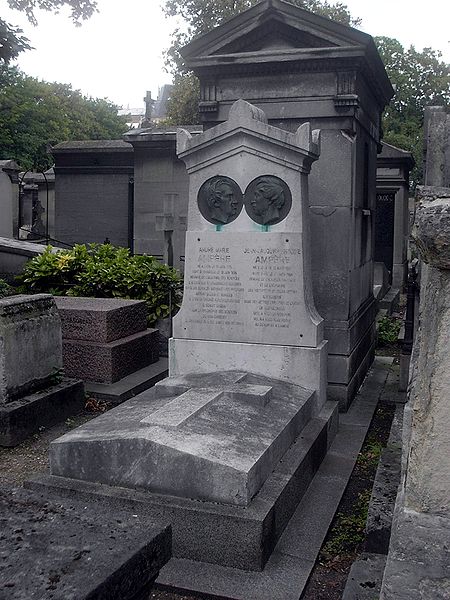<Back to Index>
- Physicist André Marie Ampère, 1775
- Composer Amédée Ernest Chausson, 1855
- King of Spain Charles III, 1716
PAGE SPONSOR


André-Marie Ampère FRS (20 January 1775 – 10 June 1836) was a French physicist and mathematician who is generally regarded as one of the main discoverers of electromagnetism. The SI unit of measurement of electric current, the ampere, is named after him.
Ampère was born in Lyon, France, on 20 January 1775 and died in Marseille on 10 June 1836. He spent his childhood and adolescence at the family property at Poleymieux-au-Mont-d'Or near Lyon. His father began to teach him Latin, until he discovered the boy's preference and aptitude for mathematical studies. The young Ampère, however, soon resumed his Latin lessons, to enable him to master the works of Euler and Bernoulli. In later life Ampère claimed that he knew as much about mathematics and science when he was eighteen as ever he knew; but, a polymath, his reading embraced history, travels, poetry, philosophy, and the natural sciences. During the French Revolution, Ampere's father stayed at Lyon expecting to be safer there. Nevertheless, after the revolutionaries had taken the city he was captured and executed. This death was a great shock to Ampère.
In 1796 Ampère met Julie Carron, and in 1799 they were married. From about 1796, Ampère gave private lessons at Lyon in mathematics, chemistry, and languages. In 1801 he moved to Bourg, as professor of physics and chemistry, leaving his ailing wife and infant son (Jean-Jacques Ampère) at Lyon. Her death, in July 1803, troubled Ampère for the rest of his life. Also in 1804, Ampère was appointed professor of mathematics at the University of Lyon.
Ampère claimed that "at eighteen years he found three culminating points in his life, his First Communion, the reading of Antoine Leonard Thomas's "Eulogy of Descartes", and the Taking of the Bastille. On the day of his wife's death he wrote two verses from the Psalms, and the prayer, 'O Lord, God of Mercy, unite me in Heaven with those
whom you have permitted me to love on earth.' Serious doubts harassed
him at times, and made him very unhappy. Then he would take refuge in
the reading of the Bible and the Fathers of the Church." Jean Baptiste Joseph Delambre's
recommendation obtained for Ampère the Lyon appointment, and
afterwards (1805) a minor position in the polytechnic school at Paris,
where he was appointed professor of mathematics in 1809. Here
Ampère continued to pursue his scientific research and his
diverse studies with unabated diligence. He was admitted as a member of
the Institute in 1814. Ampère's
fame mainly rests on his establishing the relations between electricity
and magnetism, and in developing the science of electromagnetism, or, as he called it, electrodynamics. On 11 September 1820 he heard of H.C. Ørsted's discovery that a magnetic needle is
acted on by a voltaic current. Only a week later, on 18 September,
Ampère presented a paper to the Academy containing a far more
complete exposition of that and kindred phenomena. On the same day,
Ampère also demonstrated before the Academy that parallel wires
carrying currents attract or repel each other, depending on whether
currents are in the same (attraction) or in opposite directions
(repulsion). This laid the foundation of electrodynamics. The field of electromagnetism thus
opened up, Ampère explored with characteristic industry and
care, and developed a mathematical theory which not only explained the
electromagnetic phenomena already observed, but also predicted many new
ones. In 1828, he was elected a foreign member of the Royal Swedish Academy of Science. Ampère died at Marseille and was buried in the Cimetière de Montmartre, Paris. The great amiability and childlike simplicity of his character are well brought out in his Journal et correspondence (Paris, 1872). Ampère's final work, published posthumously, was Essai
sur la philosophie des sciences, ou exposition analytique d'une
classification naturelle de toutes les connaissances humaines ("Essay
on the philosophy of science or analytical exposition on the natural
classification of human knowledge").